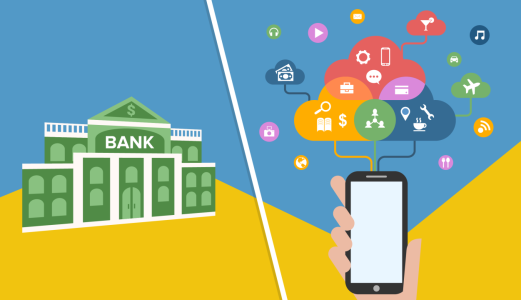The financial landscape is undergoing one of the most significant transformations in modern history. What was once the domain of marble-floored branches and tellers behind counters has now shifted into the realm of apps, algorithms, and instant transactions. From mobile banking to blockchain-driven payments, digital finance is not merely an add-on—it’s redefining the very structure of traditional banking.
The Digital Disruption of Banking
The rise of digital finance began subtly—with online banking portals and ATMs offering convenience. But over the past decade, the change has accelerated dramatically. Fintech startups have dismantled old norms, offering services that are faster, cheaper, and more personalized. Consumers no longer visit banks; their banks now fit in their pockets.
This shift has forced legacy institutions to rethink everything from customer engagement to core technology systems. Digital-only banks like Revolut, Chime, and Monzo have proven that trust and convenience no longer depend on physical presence. Traditional banks, once slow to adapt, are now racing to implement mobile-first strategies, AI-driven credit analysis, and real-time payment systems to stay relevant.
Consumer Behavior: The Catalyst for Change
Younger generations—particularly Millennials and Gen Z—are driving this transition. For them, financial management is synonymous with digital efficiency. They expect seamless experiences, instant approvals, and minimal human intervention. In a world where money moves as quickly as a text message, waiting days for transactions or visiting a branch feels outdated.
A report by Deloitte found that over 60% of consumers under 40 prefer digital-only banking. This trend isn’t just about convenience—it’s about control. Digital finance empowers users to track expenses, invest, borrow, and save on their terms, without traditional barriers or bureaucracy.
The Rise of Fintech and the Reimagining of Financial Services
Fintech companies have seized the opportunity left open by the rigidity of traditional banks. Platforms like PayPal, Square, and Stripe are now integral parts of the global payment ecosystem. Peer-to-peer lenders such as LendingClub and Prosper have made credit more accessible. Meanwhile, crypto-based platforms and decentralized finance (DeFi) protocols are experimenting with eliminating intermediaries altogether.
The result is a financial ecosystem that is more inclusive, agile, and competitive—but also more complex. The competition has forced banks to innovate, often through partnerships or acquisitions of fintech firms. JPMorgan Chase, for example, has invested heavily in blockchain and AI initiatives, while Goldman Sachs launched its consumer-focused digital bank, Marcus, to appeal to the next generation of savers.
Security, Regulation, and Trust in a Digital Age
As banking moves online, cybersecurity and data protection have become critical priorities. Digital finance brings immense convenience but also opens new vulnerabilities. From identity theft to ransomware, the risks are ever-evolving.
Regulators are responding, albeit cautiously. Frameworks like Europe’s PSD2 and the U.S. Consumer Financial Protection Bureau’s initiatives on open banking are pushing institutions toward transparency and interoperability. Yet, as innovation outpaces regulation, questions remain about accountability and systemic risk.
For customers, trust has shifted from face-to-face interactions to digital reliability. Encryption, biometric authentication, and blockchain verification now play the role that handshakes once did. The banks that will thrive are those that can balance convenience with uncompromising security.
The Human Element: Banking on Relationships in a Digital World
Despite the march toward automation, human connection remains an essential part of finance. People still seek advice, reassurance, and empathy—especially during major life decisions like buying a home or investing for retirement.
Forward-thinking banks are integrating human touchpoints into their digital strategies. Hybrid models—where AI handles routine transactions and human advisors offer strategic guidance—are becoming the new norm. The future of banking may not be entirely digital, but it will be deeply data-driven and customer-centric.
Global Implications: Financial Inclusion and Innovation
Digital finance is not just transforming banking in developed markets—it’s revolutionizing access in emerging economies. Mobile money platforms like M-Pesa in Kenya and GCash in the Philippines have given millions access to financial services for the first time. These innovations show that when technology meets necessity, financial inclusion becomes possible at scale.
As 5G, blockchain, and AI continue to evolve, they will likely create new forms of value exchange and economic participation. Traditional banks can either adapt to this inclusive future or risk becoming relics of a bygone era.
The Road Ahead: Collaboration Over Competition
The next phase of banking will not be defined by the extinction of traditional institutions but by collaboration. Banks, fintechs, and even big tech players like Apple and Google are increasingly partnering to create unified financial ecosystems.
These collaborations are blurring the lines between finance, commerce, and technology. Banking is no longer a separate industry—it’s becoming the infrastructure of the digital economy itself.
Reinventing Trust, One Transaction at a Time
The transformation of banking is far from over. What began as digitization has evolved into a redefinition of purpose and identity. Traditional banks are no longer just custodians of money—they are becoming curators of digital experiences.
In this new era, success will hinge on adaptability, innovation, and trust. The winners will be those who recognize that finance isn’t just about managing wealth—it’s about enabling progress. The institutions that master both technology and humanity will define the next chapter of global banking.



